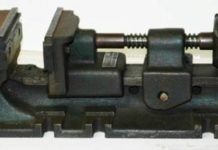OPEN HEARTH FURNACE
In open hearth furnace, pig iron, steel scrap etc. are melted to obtain steel. This furnace is widely used in American foundries for steel production. The hearth is surrounded by roof and walls of refractory bricks as shown in Fig. The charge is fed through a charging door and is heated to 1650°C mainly by radiation of heat from the burning of gaseous fuels above it. This heat is obtained by the burning of sufficiently pre-heated air and gas. Such pre-heated air of gas is obtained by passing them though arc shaped hot regenerators at a lower level. This contains fire bricks which are arranged to extract heat from exhaust gases. In the furnace air and fuel are passed through a honeycomb of hot firebrick, called checkers. It preheats the air and fuel so that they are ready for combustion when they enter the hearth. The products of combustion at the same time pass through the checkers at the other end of the furnace. The hot gases heat the checkers. The process then reverses itself, and the newly heated checkers now are used to heat the air and the fuel. It is said as a regenerative process. The products of combustion after giving up their heat to the checkers pass up through the stack. On firing of coke, the charge is heated. Part of the heat necessary, results from radiation from the low hot roof of the chamber. The furnace is raised bricked in with the charging platform, at the rear, also raised so that the charge may be put into the furnace. The melt is tapped off the front into large ladles.
The chemical composition of the end product depends upon the lining, the charge, and the control impurities added during the melt after the melt has been tapped off into the ladle. The lining plays a major roll in the control of impurities. For magnesite lined furnace, the charge consists of pig iron, limestone, and scrap iron. The limestone forms a slag. This slag and the oxygen in the air combine to remove impurities. The slag reacts with the sulfur and the phosphorus in the metal, while the bubbling air causes oxidation of the carbon and silicon. If too much carbon is present in the melt, iron ore is added. The oxygen from the iron oxide burns out the excess carbon. If the carbon content is too low, pig iron is added. This replenishes the carbon. Other alloying elements like Cr, Ni. Co, W, Mo, V etc. are added as needed.
Ferromanganese may be added to the crucible after tapping. For acid lining furnace, the charge should be scrap iron and low-phosphorus pig iron. Limestone is required to keep the slag fluid. As described above, the basic lining burns phosphorus, silicon, and carbon. The slag is tapped off by the molten metals being allowed to overflow the sides of the crucible into a slag pot.
Oxygen is one of the most important elements used in the reduction of the molten metal. Rust, scale, slag, and limestone are some of the sources of oxygen. Oxygen is introduced into the furnace with oxygen lances through the roof of the furnace. Twice the oxygen input will double the carbon reduction. This increases the steel production of the furnace.
Reference Introduction to basic Manufacturing Processes and Workshop Technology by Rajender Singh.
For engineering project visit this page regularly for know more things related project ideas. Click here to see Ideas of Projects. Engineers Gallery. All the Best!












